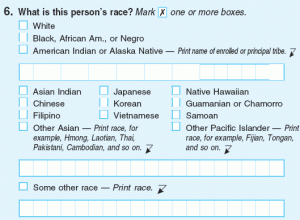Counting Race
 The U.S. population continues to become more racially and ethnically diverse. In fact, most of the growth in population from 2000 to 2010 occurred among those who reported their race(s) as something other than White alone or those who reported their ethnicity as Hispanic or Latino. While non-Hispanic White alone population is still numerically and proportionally the largest racial and ethnic group in the U.S., it experienced the slowest growth rate in this period, and Asians grew fastest, according to Census Bureau staff Karen Humes, Nicholas Jones, and Roberto Ramirez (Overview of Race and Hispanic Origin: 2010, Census Brief 2011).
The U.S. population continues to become more racially and ethnically diverse. In fact, most of the growth in population from 2000 to 2010 occurred among those who reported their race(s) as something other than White alone or those who reported their ethnicity as Hispanic or Latino. While non-Hispanic White alone population is still numerically and proportionally the largest racial and ethnic group in the U.S., it experienced the slowest growth rate in this period, and Asians grew fastest, according to Census Bureau staff Karen Humes, Nicholas Jones, and Roberto Ramirez (Overview of Race and Hispanic Origin: 2010, Census Brief 2011).
Though the overwhelming majority of the total population of the United States reported only one race, among those who reported multiple races, White and Black formed the largest multiple-race combination. Native Hawaiians, Other Pacific Islanders, American Indians, and Alaska Natives were more likely than other racial groups to report multiple races. People who identified as White were the most likely to report only one race. Hispanics identified themselves predominately as either White or “some other race,” comprising 97 percent of those identifying with the latter category.
Since 2000, growth in the Hispanic population has been mostly due to birth and immigration; for Asians it was due, in large part, to higher levels of immigration relative to other groups. The Black population, the second-largest racial group, experienced growth over the decade, but at a slower rate than all other race groups except for White.
